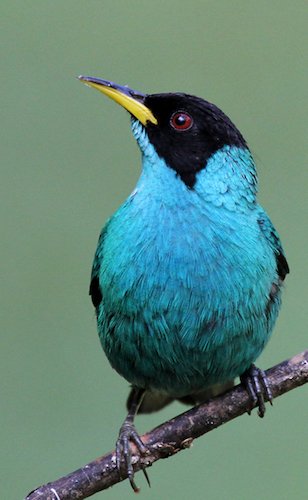State of Pernambuco

Birding Pernambuco
Pernambuco is a state of Brazil, located in the Northeast region of the country. To the north are the states of Paraíba and Ceará, to the west is Piauí, to the south are Alagoas and Bahia, and to the east is the Atlantic Ocean. There are about 185 kilometers (114 miles) of beaches, some of most beautiful in the country, as Porto de Galinhas, Carneiros and Calhetas. The capital, Recife, has one of most beautiful urban areas of the country, Boa Viagem. Together with its neighboring city of Olinda, it is one of the most cosmopolitan cities in the northeastern part of Brazil. Both have Portuguese architecture, with secular casarões and churches, and kilometers of beaches and much culture. Pernambuco also has the archipelago Fernando de Noronha. The proximity of the Equator guarantees an entire year of sun, with average temperatures of 26°C (78.8°F).Pernambuco comprises a comparatively narrow coastal zone, a high inland plateau, and an intermediate zone formed by the terraces and slopes between the two.
Its surface is much broken by the remains of the ancient plateau which has been worn down by erosion, leaving escarpments and ranges of flat-topped mountains, called chapadas, capped in places by horizontal layers of sandstone. Ranges of these chapadas form the boundary lines with three states–the Serra dos Irmaos and Serra Vermelha with Piauí, the Serra do Araripe with Ceará, and the Serra dos Cariris Velhos with Paraíba.
The coastal area is fertile, and was formerly covered by the humid Pernambuco coastal forests, the northern extension of the Atlantic Forests (Mata Atlântica) of eastern Brazil. It is now place to extensive sugar cane plantations. It has a hot, humid climate, relieved to some extent by the south-east trade winds.The middle zone, called the agreste region, has a drier climate and lighter vegetation, including the semi-deciduous Pernambuco interior forests, where many trees lose their leaves in the dry season.The inland region, called the sertão is high, stony, and dry, and frequently devastated by prolonged droughts (secas). The climate is characterized by hot days and cool nights. There are two clearly defined seasons, a rainy season from March to June, and a dry season for the remaining months. The interior of the state is covered mostly by the dry thorny scrub vegetation called caatinga. The Rio São Francisco is the main water source for this area.
The climate is more mild in the countryside of the state because of the Borborema Plateau (“Planalto da Borborema”, popularly known as “Serra das Russas” or “Russians’ Mountain”). Some towns are located more than 1000 meters above sea level, and the temperatures there can descend to 10°C (50°F) and even 5°C (41°F) in some cities (i.e., Triunfo) during the winter.The island of Fernando de Noronha in the Atlantic Ocean, 535 km northeast of Recife, has been part of Pernambuco since 1988.The rivers of the state include a number of small plateau streams flowing southward to the São Francisco River, and several large streams in the eastern part flowing eastward to the Atlantic. The former are the Moxotó, Ema, Pajeú, Terra Nova, Brigida, Boa Vista and Pontai, and are dry channels the greater part of the year.The largest of the coastal rivers are the Goiana River, which is formed by the confluence of the Tracunhaem and Capibaribe-mirim, and drains a rich agricultural region in the north-east part of the state; the Capibaribe, which has its source in the Serra de Jacarara and flows eastward to the Atlantic at Recife with a course of nearly 300 miles; the Ipojuca, which rises in the Serra de Aldeia Velha and reaches the coast south of Recife; the Serinhaen; and the Uná. A large tributary of the Uná, the Rio Jacuhipe, forms part of the boundary line with Alagoas.
-
Reserva Privada do Patrimônio Natural Frei Caneca
PDF Information…a private protected area of 630 ha - prime site for the Alagoas endemics…
-
Wikipedia
GNU Free Documentation License
Information
-
Number of bird species: 699
(As at May 2019)
-
Fundação Gilberto Freyre
Facebook PageO Sítio Ecológico da Fundação Gilberto Freyre está situado no bairro de Apipucos, na cidade do Recife, no entorno da Casa onde viveu o sociólogo e escritor pernambucano. Trata-se de uma área com cerca de 10.000m2, remanescente dos antigos quintais de tempos passados.
-
IBA Serra do Uburu
WebpageSatellite Viewust 2% of Pernambucu's Atlantic Forest survives, so despite its small size (by Latin American standards) of around 1,000 hectares, Serra do Uburu is of extreme biological importance. Recognised by BirdLife as an Important Bird and Biodiveristy Area (IBA), it is home to one of the rarest passerines in Brazil, the Alagoas Foliage-gleaner Philydor novaesi, and at least 20 other endemic species from the Atlantic Forest slopes. -
Pernambuco coastal forests
InformationSatellite ViewForests remnants are small, most with less 10 km² and surrounded by sugarcane fields.
-
2018 [10 October] - André Weiss - Fernando do Noronha
ReportFernando do Noronha is not very diverse in birdlife as it's a rather remote island. However, there are two endemic species, the Noronha Vireo and the Noronha Elaenia. Some birders just fly in, bird around the airport to see those two species and take a next flight back. That's a shame because the island is utterly beautiful and hosts also several seabird species.
-
Pernambuco Pygmy Owl Glaucidium mooreorum
WebsiteThe Pernambuco Pygmy Owl (Glaucidium mooreorum) was first described in December 2002 when two study skins were examined in Pernambuco, Brazil. The skins were originally collected in 1980 and thought to be subspecies of the Least Pygmy Owl (Glaucidium minutissimum) or Amazonian Pygmy Owl (Glaucidium hardyi). Upon closer examination of the skins, and vocalisations of the birds also obtained in 1980, it was concluded that this was a new species. The name mooreorum was chosen in honour of Dr. Gordon Moore and his wife Betty, who have made significant contributions to conservation
-
Observadores de Aves de Pernambuco
BLOGA OAP
